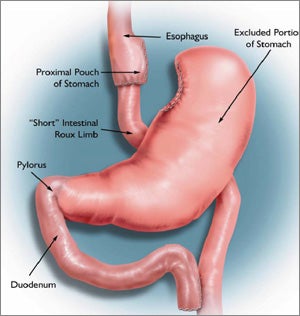
Gastric bypass surgery is a surgical procedure in which the stomach is made smaller by stapling and dividing it into two compartments. The smaller compartment is called a pouch. The larger part of the stomach is bypassed, meaning that the food is going around it, rather than passing through it. A small opening called an outlet is made in the newly formed pouch and is connected to a limb of intestine. The food will pass directly from the pouch into the intestine, but it will take several hours for the pouch to empty because the outlet opening is small making you feel full longer. Also because the pouch holds about 2 ounces of food, you will eat less food at one time – this will help you lose weight. You will eat smaller quantities of food and you will feel full very quickly. Because the limb of intestine used to empty your stomach will bypass the upper part of your intestines, it will reduce the absorption of food, which will also help you to reduce and control your weight. You will need vitamin and mineral replacements because the main stomach and the first part of the small intestine are bypassed.
As you begin to eat and take medication, remember that everything passing through the stomach must be small enough to fit through the opening of the outlet. As a guideline, food should be able to pass through a straw, which is why you are placed on a special liquid diet immediately following surgery. The goal is to let the stomach heal; only liquids and soft solids should be eaten during the first two months. Since many pills are quite large and will not fit through the outlet, we ask you to crush all medications or take them in liquid or chewable form. You will receive written instructions on the proper diet to follow from your dietitian. The food will pass directly from the pouch into the intestine, but it will take several hours for the pouch to empty because the outlet opening is small making you feel full longer. Also because the pouch holds about 2 ounces of food, you will eat less food at one time – this will help you lose weight. You will eat smaller quantities of food and you will feel full very quickly. Because the limb of intestine used to empty your stomach will bypass the upper part of your intestines, it will reduce the absorption of food, which will also help you to reduce and control your weight. You will need vitamin and mineral replacements because the main stomach and the first part of the small intestine are bypassed.
It is very important that you do not overeat, especially during the first two months following the surgery when the stomach is healing. If you eat more than your stomach can hold, you risk vomiting. Remember, the stomach is very delicate.
You also need to know about dumping syndrome, a side effect of the operation. Dumping syndrome might include one or all of the following symptoms: light-headedness, dizziness, heart palpitations, sweating, nausea, cramps, and/or diarrhea. This condition is the result of eating the wrong food, overeating, or drinking with or too soon after eating meals. The food enters the intestines quickly and causes it to distend, producing some or all of the symptoms mentioned above. Highly concentrated foods such as sweets and high-fat foods can cause dumping, so these foods should be avoided. Your dietitian will review with you substitutions for these foods.
 en
en 
 Français
Français Deutsch
Deutsch Italiano
Italiano Español
Español Tiếng Việt
Tiếng Việt Kreyol ayisyen
Kreyol ayisyen